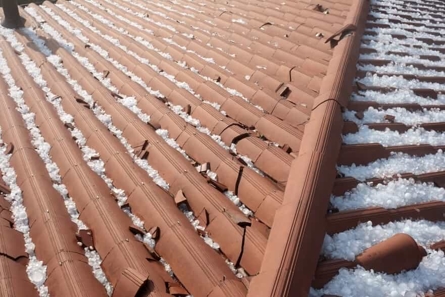If you're a homeowner in Baltimore, MD, understanding what hail damage looks like on your roof is crucial. Hailstorms can strike unexpectedly, leaving behind subtle yet significant damage. This guide will help you identify hail damage on common Baltimore roof types and provide tips on safe inspection methods.
Roof Types in Baltimore and Hail Damage Signs
Baltimore's diverse architecture means you'll find various roof types across the city. Each type of roof shows hail damage differently. Let's explore the most common roof types in Baltimore and the telltale signs of hail damage on each.
Asphalt Shingles
Asphalt shingles are the most common roofing material in Baltimore homes. They're popular due to their affordability and durability.
When hail strikes asphalt shingles, it can leave behind distinct marks. Look for dark spots where the granules have been knocked off, exposing the underlying substrate. These spots might appear shinier than the surrounding area.
In severe cases, you might notice cracks, dents, or even holes in the shingles. The edges of the shingles may also be damaged, leading to curling or lifting.
Slate Roofs
Many historic Baltimore homes feature beautiful slate roofs. Slate is prized for its natural beauty, fire resistance, and exceptional longevity.
Hail damage on slate roofs differs from asphalt shingles. Instead of dents, you might notice cracks or small chunks missing from individual slate tiles. These cracks can be subtle, appearing as thin lines across the surface.
In more severe cases, entire tiles might be broken or knocked out of place, leaving gaps in the roof's coverage. The corners and edges of slate tiles are particularly vulnerable to damage.
Flat Roofs
Flat roofs are common on Baltimore's row houses and some commercial buildings. They're typically covered with materials like built-up roofing (BUR), modified bitumen, or single-ply membranes.
On flat roofs, hail damage often appears as indentations, punctures, or cracks in the roofing material. For built-up roofs, you might see exposed felt where the protective gravel or top layer has been knocked away.
On single-ply membranes, look for punctures, tears, or areas where the membrane has been stretched or deformed by hail impact. Hail can also damage the flashing around vents, chimneys, and other roof penetrations.
Signs of Hail Damage Visible from the Ground
You don't always need to climb onto your roof to spot hail damage. Here are some signs you can look for from the safety of the ground:
Dented gutters and downspouts
Damaged siding or window sills
Splatter marks on exterior walls
Accumulation of granules in gutters (for asphalt shingles)
These ground-level indicators can alert you to potential roof damage, even if you can't see the roof itself clearly.
How to Safely Inspect Your Roof for Hail Damage
While it's tempting to climb up for a closer look, safety should be your top priority. Here's how you can inspect your roof safely:
Use binoculars for a detailed view. Stand at different angles around your property to get a comprehensive look at your roof's condition.
If possible, check your attic for signs of leaks or daylight coming through the roof boards. This could indicate severe damage.
However, in most cases, it's best to call a professional. Here's why:
Baltimore roofs often have steep pitches, making them dangerous to navigate.
Professionals have the tools and experience to spot subtle damage you might miss.
Walking on a damaged roof could worsen the problem or lead to injury.
A professional inspection provides documentation for insurance claims.
What Happens If You Don't Address Hail Damage on Your Roof?
Ignoring hail damage on your Baltimore home's roof can lead to serious problems:
Water Leaks: Damaged shingles or tiles can allow water to seep into your home, leading to interior damage and mold growth.
Structural Weakness: Over time, water infiltration can weaken your roof's structure, potentially leading to costly repairs or even roof collapse.
Reduced Energy Efficiency: Damaged roofing materials can compromise your home's insulation, leading to higher energy bills.
Decreased Home Value: A damaged roof can significantly lower your property's value and curb appeal.
Voided Warranties: Some roofing warranties require prompt repair of damage, so delaying could void your coverage.
Addressing hail damage promptly not only protects your home but can also save you money in the long run by preventing these secondary issues.
Call ServiceMaster by Singer to Inspect Your Roof for Hail Damage
After a hailstorm in Baltimore, don't leave your roof's condition to chance. ServiceMaster by Singer has the expertise to thoroughly inspect your roof and identify any hail damage.
Our professionals understand the unique challenges of Baltimore roofs, from historic slate to modern materials. We'll provide a comprehensive assessment and guide you through the next steps if damage is found.
Don't risk your safety or miss hidden damage. Contact ServiceMaster by Singer today or call at (410)346-9336 for a professional roof inspection. Protect your home and your peace of mind.


